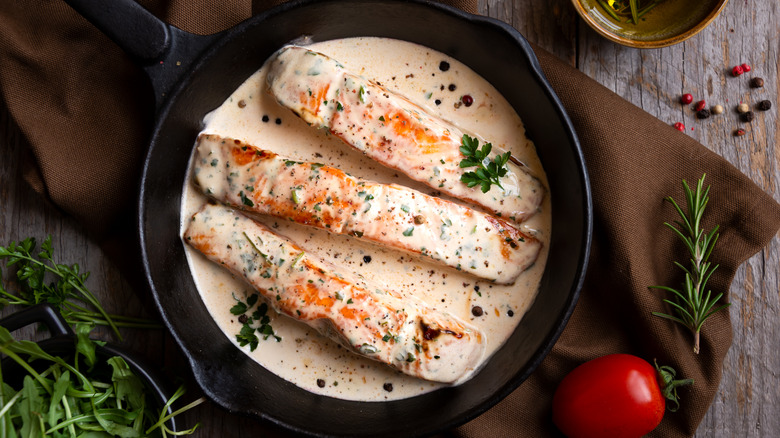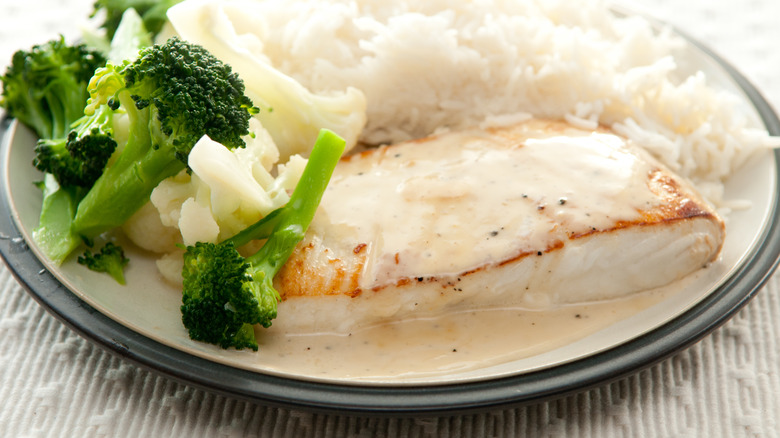Poach Fish In Milk For A More Flavorful Catch-Of-The-Day
Fish is notoriously easy to overcook, and sometimes it seems that no matter what method you use, the result is a tough and rubbery fillet. But, poaching fish in milk can be a gentler approach that uses lower heat while imparting moisture — and tons of flavor.
Poaching fish is gently simmering it in a liquid for a longer period of time than you'd use for a higher heat cooking method, like pan-searing or grilling. Rather, it uses low, moist heat to ensure the meat doesn't dry out as the warmed liquid gradually cooks it through. Wine, broth, and water are common options for poaching fish if the goal is to avoid added fats. However, milk makes for an exceptionally flavorful base, and its fat content actually helps the fish soak up its creamy flavor as well as any spices or herbs you've added to the liquid, like fresh garlic. Poaching just about anything in a fat will yield juicy and tasty meat — think butter-poached lobster.
When it comes to fish, milk works better with heartier, firmer types such as cod, tuna, and salmon. Any fillet or steak that will hold its shape is well-suited. Denser swordfish, halibut, tilapia, and haddock are also perfect for poaching in milk. Daintier-fleshed fish, like a branzino or flounder, won't hold up as well and may result in a mushy mouthful. When you choose the appropriate type of fish and grab that gallon of milk, a flaky and flavorful forkful is yours for the making.
Tips and tricks for poaching fish in milk
To get the best poached fish results, there are some keys to keep in mind. Fattier milk, such as whole or 2%, will impart a rich flavor. You could also use half-and-half for an even creamier final product. However, lower-fat versions, and even non-dairy milk, will work as well. Coconut milk or nut-based milk can add a depth of flavor and silkiness to your dish. Just be sure to remove the skin before poaching because it will get soggy. You may want to salt the milk for added flavor as well.
You can also kill two birds with one stone and add a handful of bitter, dark greens to get a flavorful side dish, too. The milk will work double duty at tenderizing and softening the flavors and textures of the veggies while doing the same for the fish. You can also add specific aromatics for a fun flavor profile; ginger and lemongrass will give you a Thai spin, whereas thyme and fennel will have you leaning more French in style.
Another option is to use the milk you poached the fillet in to make a quick pan sauce. Once the fish is cooked through, remove it and crank up the heat on the dairy to reduce it to a thicker consistency that's more concentrated in flavor, and add a little flour to thicken the sauce if need be.
Other benefits of cooking fish in milk
A flavor boost isn't the only plus to poaching fish. The fatty acids in milk will also help tenderize its flesh and make for a more delicate bite. Think of taking a meat mallet to a tough steak to break down the proteins for a more supple mouthful.
And there's another bonus too. Perhaps you already know that soaking fish in milk helps with unpleasant smells, and a milk bath before cooking shrimp can also be a game changer for preventing a smelly kitchen after a shellfish supper. That's because the milk helps to assuage powerful fishy scents, especially with more pungent varieties of seafood.
But, when adding the milk in at a later step and cooking the fish in it, as in poaching, that helps too. When it comes to fishiness, poaching with milk has a similar effect on taste as soaking does to scent. This method works well with intensely flavored fish, such as anything smoked or salted. The proteins in the milk will bind to any oxidized fatty acids responsible for the pungent taste and smell, to soften the essence.



